
4th Issue 2004
ABC of "lap-mei"?
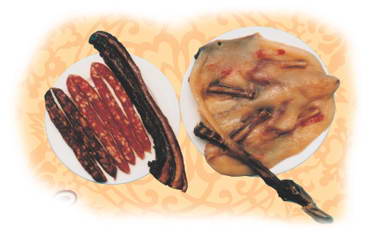
The howling moonsoon and cold weather remind us of the Chinese delicacy "lap-mei". In many Chinese restaurants, "lap-mei" dishes are now back to the centre stage. "Lap-mei", with its characteristic aroma, often whets our appetite. But how much do you know about "lap-mei"?
The method of meat curing has been employed since ancient times. In ancient China, "lap" means "sacrificial rites" and very often surplus meat after the rites would be cured and stored for consumption in times of scarcity. In the old days, it was a tradition to cure meat in the twelfth month of the lunar year which served as a delicacy to cerebrate the Spring Festival. With the invention of refrigerating equipment, curing as a way to preserve meat has lost its lustre. Nevertheless, the unique texture and distinct flavor of traditionally cured meat continue to charm modern people as an important alternative of fresh meat.
The manufacturing process of "lap-mei"
Raw materials like pork, duck and duck liver must be cleansed and sliced before the curing ingredients such as salt, sugar, wine and nitrates or nitrites are added. The mixture is then placed in chillers to allow thorough distribution of curing ingredients. The meat is then dried. In the past, the meat was often air-dried. However, the traditional air-drying process requires ample space for hanging and loading, not to mention the unpredictable climate and the long duration required. Today, the trade largely prefers the method of hot air-drying and the meat is put in an air-conditioned chamber at a temperature ranging between 35oC and 40oC to allow a more rapid vaporization of moisture. Take the preserved Chinese sausages as an example, the whole drying process can be completed in 3 to 4 days.
Why are nitrates or nitrites added?
Nitrates or nitrites have a unique place in meat curing. They can enhance food safety because of their anti-microbial property especially on Clostridium botulinum and the inhibition of toxin production.
Clostridium botulinum is a gram-positive, spore-forming, anaerobic rod that can cause fatal infection. It is known to exist in anaerobic conditions. Therefore, vacuum-packaged food such as bacon and canned processed meat can support growth and toxin production by Clostridium botulinum strains without causing noticeable smell. In preserved meat especially meat sausages, spores of the bacteria can germinate, grow and produce toxin if the temperature is not properly controlled. Besides, Clostridium botulinum can also grow in food with high water content.
Nitrates or nitrites also have other important functions. Firstly, they render the cured meat red-pinkish in colour by stabilizing the haem in myoglobin through the formation of nitrosomyoglobin. Secondly, they can delay the process of oxidative rancidity of meat and, hence, prevent the development of a rancid smell resulting from prolonged storage.
Health Effects of Nitrate and Nitrite
Nitrate per se has a relatively low toxicity, whereas nitrite has a more significant effect on the human body. Nitrates at levels commonly present in food are not toxic to human However, they can be converted into nitrites by the intestinal bacteria in human body.
Accidental intake of large amount of nitrite can cause methaemoglobinaemia. The symptoms include headache, weakness, breathlessness, and a bluish discolouration of the skin and mucous membranes called cyanosis. Methaemoglobinaemia resulting from exposure to food contaminated with nitrite is extremely rare. The development of methaemoglobinaemia is determined by the ingested dose and individual susceptibility. For mild cases of methaemoglobinaemia, the patients usually recover without specific treatment.
There is currently no evidence that nitrate and nitrite exposure is associated with the formation of cancer in human. However, they can combine with amines and amides in food to form an N-nitrosocompound called nitrosamine. Experiments on animals reveal that certain nitrosamines are carcinogenic and epidemiological studies also indicate that certain nitrosamines are cancer-related.
Advice to the Trade
The trade should adopt the following advices on the purchase of ingredients, and preparation and storage of "lap-mei":
Purchase of Ingredients
- Purchase from reliable and reputable suppliers.
- Use only fresh meat and ingredients of high quality.
- Observe good manufacturing practice and use food grade nitrates and nitrites.
Preparation Process
- Do not use nitrate or nitrite excessively. The minimum amount of nitrate or nitrite sufficient for their intended purposes should be used.
- Mix the curing agents well and ensure that they are evenly distributed on the meat.
- Make sure contamination does not occur, no matter whether the "lap-mei" is dried under natural or artificial condition.
Storage Conditions and Period
- Meat should be properly kept in chillers when being cured.
- Store finished "lap-mei" under cool and dry conditions.
- Despite having gone through the curing process, "lap-mei" should not be stored for too long lest it becomes spoiled and produces a rancid smell.
Existing Regulatory Measures
The articles of food which may contain preservative and the nature and proportion of preservative in each case are stipulated in the First Schedule to the Preservatives in Food Regulations made under Section 55 of the Public Health and Municipal Services Ordinance (Cap 132). As far as "lap-mei" and preserved Chinese sausages are concerned, the permitted preservatives include nitrate and nitrite, and their proportions must not exceed 500 and 200 parts per million respectively. Any person who contravenes the ordinance shall be liable to a fine of $50,000 and to imprisonment for 6 months.
Village Casserole Dish "Poon Choi"
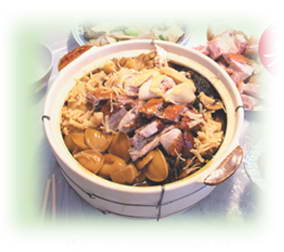
In recent years, enjoying a steaming hot "poon choi" with family members or friends has gained popularity particularly at times of traditional festivals. The large assortment of food contained in a pot of "poon choi" guarantees that there are favourite foods for each person. Many restaurants are offering "poon choi" with various recipes. Simply place an order with one of the restaurants, and you can enjoy the delicacies with friends and relatives.
From a food hygiene perspective, "poon choi" , which comprises of different kinds of foods, is in general more complicated to prepare and cook than a single dish. When preparing "poon choi" , the trade should note the following key points:
-
Purchasing and Collection of Food Ingredients
- All food ingredients should be purchased from reputable and reliable suppliers.
- Inspect the food and ingredients upon their delivery to ensure that the temperatures of chilled and frozen food are well controlled when they arrive.
-
Storage Facilities and Temperature Control
- Observe the "first-in-first-out" principle.
- The temperature of chillers should be kept at under 4oC, and the temperature of freezers should be kept at under -18oC.
- Cooked food should be stored above raw food. Cooked and raw food should preferably be stored in separate storage compartments.
-
Food Handling and Cooking
- Note the specific date and time for the collection of "poon choi" by customers and carefully devise a schedule for preparing poon choi to avoid premature cooking.
- Before food handling, all surfaces that will come into contact with food, such as crockery, cutting boards and kitchenware, should be thoroughly cleaned and sterilized.
- Frozen food should be defrosted by refrigerator or under running water.
- Large chunks of food should be cut into smaller pieces in advance to facilitate thorough cooking.
- Food must be thoroughly cooked.
- High-risk food susceptible to contamination, such as sea food and poached chicken, must be thoroughly cooked and stored separately to prevent cross contamination.
- After being cooked, food ingredients should be either kept chilled at under 4oC, or kept hot at over 60oC.
- Food should be properly covered to prevent cross contamination.
-
Delivery
When delivery of poon choi is required, ensure that:
- The container for food delivery must be clean, covered and equipped with food-warming facilities;
- The delivery vehicle must be clean.
-
Personal Hygiene
- Before preparing poon choi, keep good personal hygiene: Wash your hands before preparing food or after using the toilet, and do not cough or sneeze into food, etc.
- No food should be handled by workers with symptoms of gastroenteritis or infected with flu, etc.
-
Remind Customers of How Poon Choi Should be Handled
- Poon choi should be consumed as soon as possible after collection.
- Poon choi not consumed right away should be stored in a refrigerator. Before it is consumed, poon choi should be reheated until its core temperature reaches 75oC or above.
- As a pot of poon choi is quite voluminous, it will take a longer time to reheat.
- Additional chopsticks should be used for common serving of food.
Sweeteners in Food
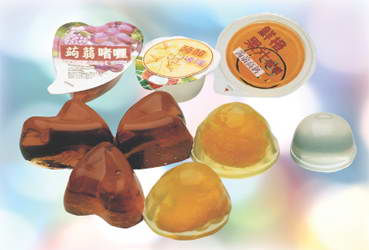
It is nice to enjoy sunshine and deserts in holidays. However, many city dwellers are more concerned about "keeping fit" nowadays. To cater for the needs of these consumers, food manufacturers have replaced sugar with sweeteners in their products like soft drinks, candies, chewing gum and dessert. Sweeteners may soon become a new "sweetheart" on dinning table, threatening the dominance of cane sugar.
What is sweetener?
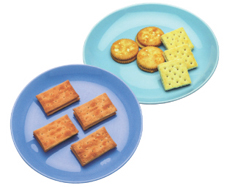
There are two categories of sweeteners, namely naturally occurring sweetening agents and synthetic compounds. They are either extracted naturally from plants or chemically synthesized. Some sweeteners are tens of times more sweet than cane sugar and only a small quantity of them will suffice to sweeten food, but the calories they entail are much lower than that of cane sugar. Since these sweeteners have lower calories and do not affect the levels of insulin or blood glucose, they are ideal alternatives for diabetics or people who want to lose weight.
Are sweeteners safe?
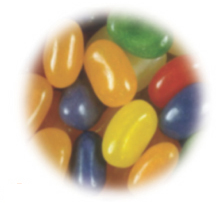
Like all the other food additives, sweeteners have to undergo stringent safety assessments before they are permitted for use in food. The Joint Food and Agriculture Organization / World Health Organization Expert Committee on Food Additives (JECFA) evaluates the safety of sweeteners based on toxicological data from animal and human studies and recommends a list of sweeteners for human consumption. In normal circumstances, these sweeteners will not pose any harmful effects to humans, in particular, they are not harmful to growing fetus and do not induce cancers.
Legislative Controls in Hong Kong
According to the Sweeteners in Food Regulations made under the Public Health and Municipal Services Ordinance (Cap. 132), eight groups of sweeteners are permitted for use in Hong Kong. Any person who uses non-permitted sweeteners in any food shall be guilty of an offence and shall be liable of conviction to a maximum fine of $50,000 and imprisonment for 6 months.
The eight groups of sweeteners are: Acesulfame Potassium, Alitame, Aspartame, Aspartame-acesulfame Salt, Cyclamic Acid (and Sodium, Potassium, Calcium Salts), Saccharin (and Sodium, Potassium, Calcium Salts), Sucralose and Thaumatin.
Advice to Consumers
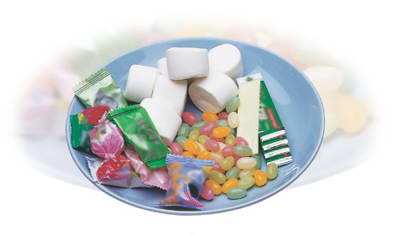
- Food manufacturers should only use sweeteners stipulated in the Sweeteners in Food Regulations.
- More than one sweetener may be used so as to reduce the intake of one single sweetener.
- According to the Food and Drugs (Composition and Labelling) Regulations, pre-packaged food must be correctly labelled. The label must list the additive by its functional class, its specific name or its identification number under the International Numbering System for Food Additives.
Facts about "Fabricated Beef"
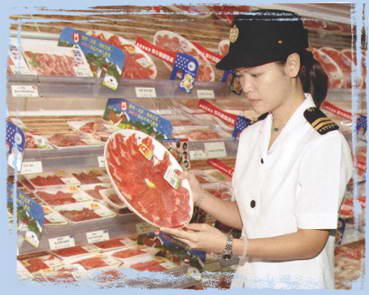
Taiwan media reported earlier that the low-priced steaks offered by a number of local chain steakhouses were fabricated from "restructured/reconstituted beef" . As a result of the wide media coverage, some of these restaurants ceased offering these kinds of beef product. But the decision was made purely on commercial ground rather than on food safety ground. In fact, fabricated steaks are not new. Resembling ordinary steak in appearance, yet cheaper in price, they are embraced by customers and have been in common existence in overseas countries.
What is fabricated beef?
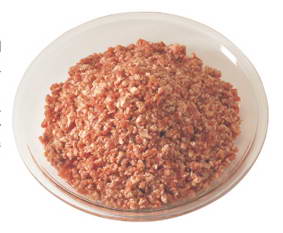
Fabricated beef are beef products which have undergone processes like chopping/mincing, combining/bonding and seasoning. There are two types of fabricated beef namely restructured and reconstituted beef. Restructured beef has the connective tissue removed before bonding and shaping. Reconstituted beef, on the other hand, comes from beef trimmings mixed and pressed to shape. Fabricated beef are commonly used for making sausages and burgers.
How do I know if a steak is fabricated or natural?
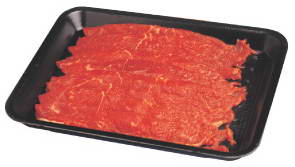
Characteristics of fabricated steaks:
- Almost identical in shape and size because the beef is pressed to shape in the process
- Disordered muscle grain can be seen on cross-sections
- Less juicy when compared with their natural counterpart because of the lower moisture-holding capacity
- May taste better as additives (e.g. seasoning) might have been added during processing
- Loss of chewy texture and less resilience as the connective tissue has been destroyed during processing
Characteristics of natural steaks:
- Vary in shape and size
- Orderly muscle grain
- Higher moisture-holding capacity and therefore more juicy
- Tender and chewy texture
What is the risk of consuming fabricated steaks?
During slaughtering, the surface of beef may be contaminated by bacteria like Esherichia coli O157:H7. Since the fabrication of steaks involved chopping/mincing of beef, the bacteria on the surface may find its way into the core of the steak. The more the processing, the greater the chance of contamination. Moreover, as many people are in favour of half-cooked steak, it is likely that the bacteria inside cannot be eradicated. Therefore, fabricated steak must be thoroughly cooked before consumption.
How to prevent and reduce the risk when purchasing and handling fabricated steak?
Points to note when purchasing and handling fabricated steak:
- Generally speaking, fabricated steaks are frozen food (which should be kept at a temperature below -18oC). Upon receipt of the consignment, check the temperature and condition.
- After receiving the consignment, store the steak in the freezer at a temperature below -18oC.
- Defrost the steak in the refrigerator at a temperature between 0oC and 4oC.
- Fabricated steak should be thoroughly cooked.
- Customers ordering half-cooked steak should be notified that the steak they order is made of fabricated beef which should be thoroughly cooked for safe consumption.